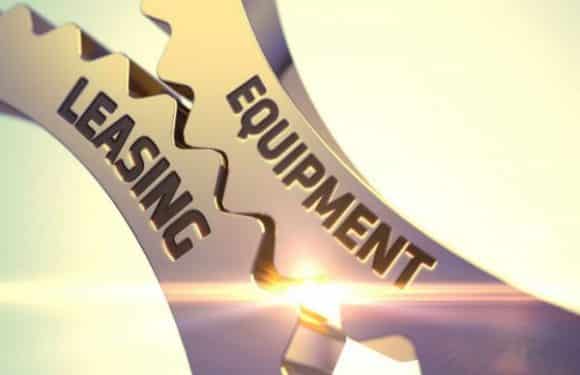Another option to reduce equipment costs is to lease rather than buy. Nowadays, almost anything may be rented, from computers and heavy machinery to entire workplaces. The type of business you run and the type of equipment you’re contemplating are important considerations when deciding whether to lease or buy. Let’s learn more about this business financing method, equipment leasing, note types, and the processes involved and determine if it’s suitable for your company. We’ll also see in detail all about the equipment leasing agreement. Read on!
What is Equipment Leasing?
Equipment leasing is one of the types of business financing in which the small business owner rents rather than buys the equipment. Businesses can lease expensive equipment such as machinery, trucks, computers, and other instruments needed to conduct their operations. So, the equipment is leased for a set amount of time. When the contract expires, the business owner must either return the equipment, extend the lease, or purchase the equipment.
Equipment leasing differs from equipment financing, which involves taking out a business loan to purchase the equipment and repaying it over a set period of time using the equipment as collateral. In that situation, once you pay off the loan, you will own the equipment.
When you lease equipment, the equipment is not yours to keep once the lease period expires. When leasing equipment, you pay interest and fees in addition to the (typically) monthly payment. Insurance, maintenance, repairs, and other related costs may incur additional charges.
Equipment leasing can be significantly more expensive in the long run than owning equipment outright. However, for cash-strapped small business owners, it’s a way to get needed equipment without spending a lot of money upfront.
How Equipment Leasing Works?
If you want to lease rather than buy equipment for your business, you will enter into a leasing agreement with the equipment owner or vendor. The equipment owner prepares an equipment leasing agreement, similar to how a rental agreement works. The agreement outlines how long you’ll lease the equipment and how much you’ll pay each month.
During the leasing time, you have access to the equipment until the agreement expires. There are several circumstances in which you can break the lease – and they should be included in the contract – but many leases are noncancelable. When the lease term expires, you may be able to purchase the equipment at the current market rate or cheaper, depending on the vendor.
The rates you pay to lease the equipment vary depending on the leasing firm. The rates you’re charged are also affected by your credit score. The riskier the loan, the more expensive it will be to lease equipment. A lease for equipment can be granted online in a matter of minutes. Leasing firms typically specialize in specific industries, so it’s critical to conduct your research to discover the best vendor for your needs.
Depending on the type of equipment, leasing lengths are commonly three, seven, or ten years.
Because equipment leasing is not a loan, it will not appear on your credit report and will not impair your capacity to borrow. In many circumstances, the IRS allows you to deduct your equipment lease payments provided you use the leased equipment for business purposes. If the tax deduction is a motivating element in your decision to lease the equipment, consult with a tax advisor. If the IRS considers the lease to be an installment sale, it has the authority to refuse the deductions.
Advantages of Equipment Leasing
- Many lessors do not require a large down payment.
- If you need to update your equipment regularly, leasing is an excellent alternative because you aren’t stuck with old equipment.
- You can upgrade to more advanced equipment to manage a bigger amount of work without having to sell your existing machinery and shop for replacements.
- Tax benefits are frequently available for equipment leases. Depending on the lease, you may be eligible to deduct the payments as a business expense if you use Section 179 Qualified Financing.
In fact, not all equipment leases are the same, and there are numerous methods for financing a lease. If you wish to lease equipment for your business and finance it with a loan, we propose you read our review of the alternative lender we recommend for equipment loans. The lender we selected as the best overall offers leasing choices as well.
If you’re not sure if equipment leasing is a good fit for you, keep reading to learn more about how to get started, the leasing process, the many types of leases available, and what to look for while looking for a lender.
Where do I begin?
Answer the following questions before beginning the process. It may appear to be a lot of work upfront, but without addressing these questions as they pertain to your business, you will be unable to make an informed decision on leasing or purchasing equipment.
#1. What is your monthly spending plan?
Although leasing involves cheaper monthly payments than purchasing, you must still include the expenditures into your monthly cash flow. Begin with what you can afford and work your way up; don’t start with price quotes and then try to fit them into your budget.
#2. How long will the equipment be in operation?
Leasing is almost always the most cost-effective option for organizations when it comes to short-term use. If you plan to use the equipment for three years or more, a loan or conventional line of credit may be preferable to a lease. Consider your organization’s growth as well: If your firm is fast expanding and evolving, leasing may be a better option than buying.
#3. How soon will the equipment be obsolete?
Some industries experience faster technological obsolescence than others. Before you decide whether to buy or lease, think about obsolescence.
Is it possible for you to lease your equipment?
The equipment that can be leased is nearly endless. However, there are a few conditions.
#1. Purchase price:
Equipment leasing allows organizations to get high-value equipment and machinery. This includes anything from expensive single products like heart monitors and extraction machines to smaller items that are needed in bulk like kiosks, software licenses, and telephones. As a result, equipment leasing agreements for purchases under $3,000 are uncommon, and many large lenders require a minimum purchase of $25,000 to $50,000.
#2. Hard assets:
The equipment you lease must be deemed a hard asset, which is defined as anything that could be classified as personal property and is not permanently tied to real land. Soft assets, such as training programs and warranties, are not eligible for lease programs.
The key point is that equipment costing less than $3,000 may be difficult to lease. Furthermore, the equipment must be classified as a hard asset.
What to Expect During the Leasing Process
When applying for a lease, you should anticipate the following stages.
Step 1:
You fill out an application for equipment leasing. Make sure you have financial documentation for your firm and its principals on hand, as this may be necessary before or after you apply.
Step 2:
The lessor reviews your application and informs you of the outcome. This normally occurs within 24 to 48 hours of your application being submitted. For applications ranging from $10,000 to $100,000, some lessors may not require financials and/or a business plan. Expect to offer detailed financials as well as a business plan for financing ranging from $100,000 to $500,000 (and up).
Step 3:
Once approved, you must evaluate and finalize the lease arrangement, which includes monthly payments and the fixed APR. The documentation will then be signed and resubmitted to the lessor, usually along with the first payment.
Step 4:
Once the lessor has received and approved the signed documentation and initial payment, you will be notified that the lease is in place and you can take delivery of the equipment and begin any necessary training.
Step 5:
Funds are transferred straight to you or the manufacturer from whom you are purchasing within 24 to 48 hours.
Types of Equipment Leasing
The following two types of equipment leasing are available:
#1. Lease on Capital
A capital lease is often long-term and non-cancelable, and it is used for leasing equipment that the company intends to use long-term or purchase after the lease period. The lessee is responsible for maintaining the asset and paying any insurance and taxes related to the equipment under this lease. During the lease period, the assets and liabilities of the equipment are documented in the lessee’s balance sheet. When renting expensive capital equipment that they may not have the cash to purchase right away, businesses prefer this sort of lease.
#2. Operating Contract
An operating lease is typically for a short length of time and is terminable before the lease period expires. It is typical for businesses that only need the equipment for a short time or want to replace it after the lease. The lessor retains ownership of the equipment and is responsible for its obsolescence. A lessee can cancel the equipment leasing agreement at any moment before the lease period expires, although usually with a penalty.
Aside from the two types of equipment leasing stated above, there are other types of equipment leasing that mix the characteristics of capital and operating leases to satisfy the demands of both parties. For tax and economical reasons, the lessor may choose a hybrid equipment lease. Leveraged leases allow the lessee to fund the lease cost by issuing debt and equity against the payments on the equipment lease.
Equipment Leasing Agreement
An equipment leasing agreement is a contractual agreement in which the lessor, who owns the equipment, allows the lessee to use it for a set length of time in exchange for monthly payments. Vehicles, factory machines, or any other equipment may be the subject of the lease. Once the lessor and lessee agree on the lease terms, the lessee receives the right to use the equipment in exchange for making monthly payments for the life of the lease.
The lessor, on the other hand, retains ownership of the equipment and has the authority to cancel the equipment leasing agreement if the lessee violates the terms of the agreement or engages in illegal behavior while using the equipment.
An Equipment Leasing Agreement Components
A leasing agreement for equipment includes certain provisions that serve as the contract’s foundation. Some of these terms could be:
#1. Term of the lease
The length of the leasing will be determined by the needs of the company and the cost of the equipment. A short lease length is a good alternative for a small business whose equipment demands vary frequently. Longer lease terms are more convenient and cost-effective in the long run for pricey capital equipment.
#2. Monetary terms
The equipment leasing agreement provides payment schedules, such as when recurring payments are due and the last due date for late payments.
#3. The lessor’s payment due.
An equipment leasing company evaluates its forecasted cash flows to see whether it will be able to satisfy the periodic interest and principal payments. The payments are made over a period of several months until the lease period expires or the lessee assumes ownership of the equipment if there is an existing arrangement with the lessor.
#4. Equipment Market Value
Some equipment is costly, and the lessee must be aware of the market worth of the equipment before entering into the contract. Knowing the market value assists the lessee in determining the insurance costs to safeguard against equipment loss or damage.
#5. Tax Liability
Depending on the form of lease, the lessee may be obligated to pay certain fees on the equipment, such as taxes. Knowing the tax responsibilities under various types of equipment leasing will assist the lessee in avoiding the dangers of unplanned spending.
#6. Cancellation Clauses
The instructions for agreement termination must be included in the equipment leasing agreement. A company may decide to cancel the leasing arrangement in the middle of it, either because they have found a better alternative or because the equipment is malfunctioning or old. If the true penalty rates were not disclosed at the outset, some equipment leasing company may levy punitive penalties. Technology-based equipment becomes obsolete quickly, and an equipment leasing company may need to identify replacements swiftly to stay ahead of the competition.
#7. Renewal options for lessees
Lessee renewal choices outline the renewal process as the lease time comes to an end. The lessee may desire lower monthly payments or the option to purchase the equipment at the end of the lease period.
Responsibilities of Lessee
There are additional obligations that can result in costs in addition to your monthly leasing payment. Typically, these include the following items:
- Insurance: Annual liability insurance estimates range from $200 to $2,200, with many businesses reporting expenditures of $1,000 or less.
- Extraneous costs: Depending on the terms of your lease, you may be responsible for some upkeep and repairs. Extraneous charges may also include legal fees, fines, and certification costs.
- Equipment return: This covers transportation and shipping charges.
- Fees: Carefully read your contract. Fees can be levied for anything from a one-time documentation cost of up to $250 to late-payment fees ranging from $25 to 15% of the amount owed.
Advice on Choosing a Lessor
The best tip for selecting a quality lessor is to analyze them with the same level of scrutiny that you and your business are subjected to. Give preference to individuals who are willing to collaborate with your equipment leasing company. This could be demonstrated by their amount of expertise and experience in your line of industry, or by their willingness to collaborate with you on certain conditions. Some lessee obligations expenses, particularly application fees and late fees (at least on the first late payment), may be paid or eliminated depending on the lessor.
Also, spend some time researching the following:
- Examine the payment history, credit history, business profile, corporate relationships, financial records, and any public filings.
- Pending litigation: Look for any notices of pending litigation in public records.
- Is the payment system simple, or does it necessitate mountains of paperwork?
Inquiries to Make with a Dealer
Get price quotations from at least three companies before deciding on a dealer, and ask these questions to all of the dealers on your list. Asking the proper questions is half the fight when it comes to negotiating a fair price for business services and items.
How much cash is needed upfront?
Lease financing frequently covers the entire cost of equipment acquisition. Loans, on the other hand, frequently require up to 20% of the total as a down payment. Consider reassigning funds to cover any upfront charges if a down payment is necessary.
Who is taking advantage of the tax break?
Your corporation can claim depreciation under a loan structure. However, a down payment is required, and the interest rate is greater. The lessor claims depreciation under a lease. In exchange, they provide a cheaper APR – frequently half that of a loan. If you value the depreciation credit and still wish to lease, inquire about the availability of finance or capital leases.
Are the terms of the funding flexible?
Equipment leasing is frequently seen as the most adaptable financing option, particularly when compared to loans. Depending on the lease structure, you can begin with low payments and gradually increase them (known as a “step-up lease”). You can also postpone payment to allow yourself an extra window before the first payment is due. You may even add more equipment onto an existing lease under a “master lease” arrangement.
- EQUITY FINANCING: Types, Sources, Advantages & Disadvantages
- Financial Capital: Overview, Sources, Examples, Types (+ free tips)
- What are the Types of Brokers and Brokering Services?
- Tenancy at Sufferance Practices in the US (+ Detailed Guide)
- REAL ESTATE DEVELOPMENT BUSINESS: How to become a Developer and detailed steps to start a company






